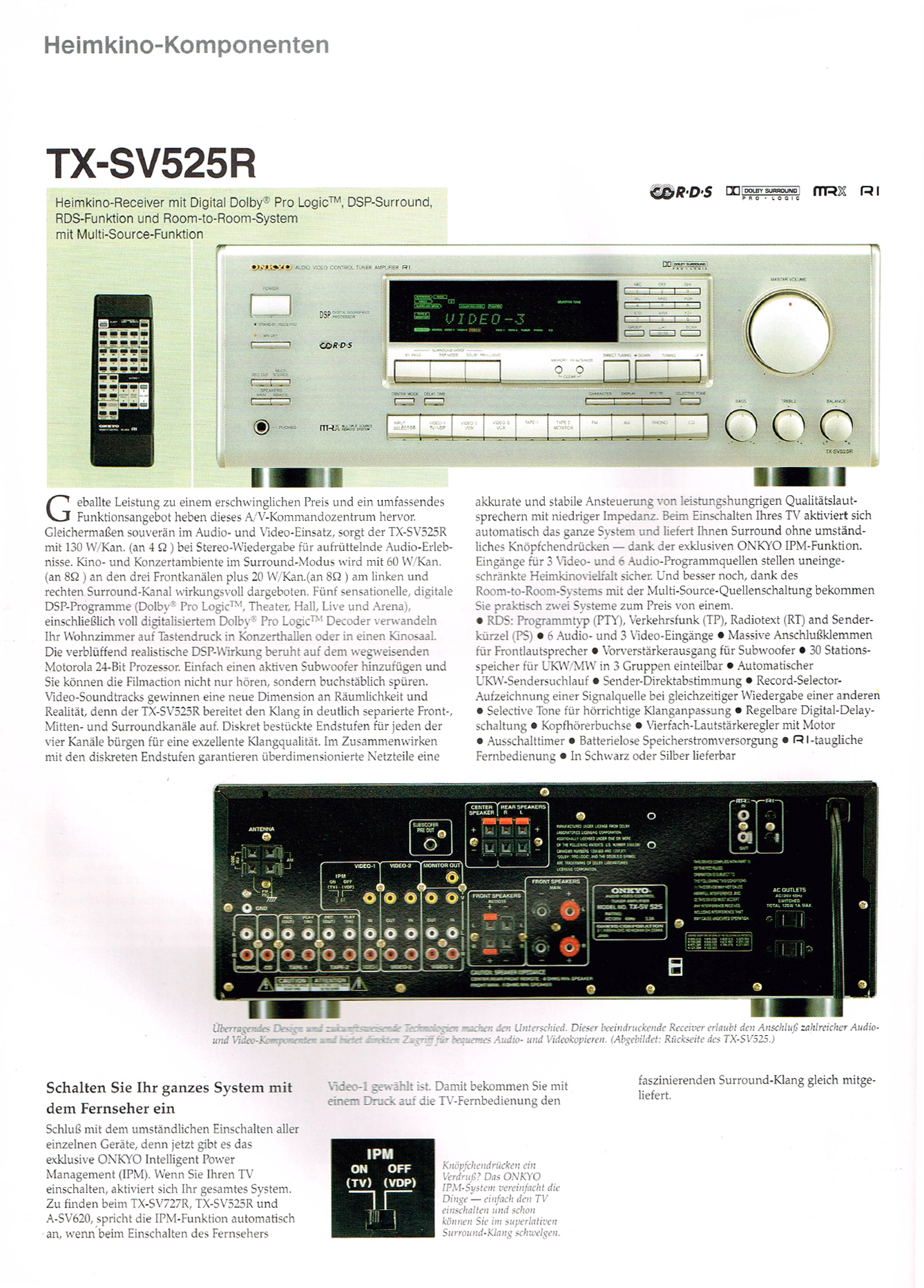Onkyo TX-SV 525 R
Data
General
- Manufacturer: Onkyo
- Model: TX-SV 525 R
- Type: A/V receiver
- Years of manufacture: 1995 - 1996
- Made in: Malaysia
- Colours: Silver, Black
- Remote control: yes
- Dimensions (WxHxD): 455 x 170 x 389 mm
- Weight: 11.8 kg
- Original price approx.: 1'100 DM, 1995
Connections
- Inputs:
- Video:
- Video 1
- Video:
Video 2 (In + Out)
- Video 3 (In + Out)
- Monitor (Out)
Audio:
- Phono
- CD
- Tape 1 (In + Out)
- Tape 2 (In + Out)
- Video 1
- Video 2 (In + Out)
- Video 3 (In + Out)
- Monitor (Out)
- Outputs:
- Preamplifier output for a subwoofer.
- Loudspeaker connections:
- Front Left + Right (main speakers on screw terminals).
- Rear Left + Right (Surround)
- Center (Surround)
- Remote Left + Right
- Headphone jack on front panel
- 2 switched sockets on the rear panel with 120 W Max each
Technical Data
- Output power:
- 2 x 80 watts stereo
- 3 x 60 watts + 2 x 20 watts in surround mode
- 2 x 60 watts in side room
- Distortion factor: 0.08 % at rated power
- Attenuation factor: 60 (into 8 ohms)
- Frequency response: 20 - 30,000 Hz, +/-1 dB
- 30 preset station memories
- More data at "Hifi-Engine": [1]
Special Features
- Digital Soundfield Processor with Dolby Pro Logic Surround Processor.
- Dolby Surround
- Multi-Room
- RDS radio
- Soundfields:
- Theater
- Concert hall
- Arena
- Live
- Delay times configurable
- Center mode (center speaker large, small or not present)
Remarks
- Other models in the same series:
- Onkyo TX-910
- Onkyo TX-8410 R
- Onkyo TX-8510 R
- Onkyo TX-SV 414 PRO
- Onkyo TX-SV 424 R
- Onkyo TX-SV 515 PRO
- Onkyo TX-SV 525 R
- Onkyo TX-SV 727 R
- Onkyo TX-SV 919 THX
- Onkyo TX-V 940 RDS
Pictures
- Extract from brochure: Onkyo TX-SV 525 R
Reports
- As usual with Onkyo, the amplifier can "remotely control" other Onkyo equipment via RI connection. Using the IPM function, the receiver can be turned on automatically when the TV comes on. Thus one has immediately the full sound. In addition, the receiver has "MRX" (Multiple Source Remote System) on board. This means that you can place the speaker pair "B" (called "Remote" here) in another room and use it there completely independently of the main room. E.g. listen to a CD in the main room and the radio in the next room. The volume of the loudspeakers is also controlled independently. Additional devices can also be used to "connect" an additional remote control in the next room or to control further devices.
